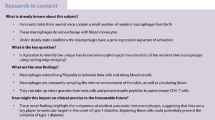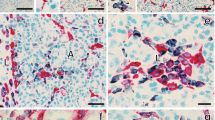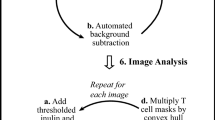Abstract
In type 1 diabetes mellitus (T1DM), the processes which control the recruitment of immune cells into pancreatic islets are poorly defined. Complex interactions involving adhesion molecules, chemokines and chemokine receptors may facilitate this process. The chemokine, monocyte chemoattractant protein-1 (MCP-1), previously shown to be important in leukocyte trafficking in other disease systems, may be a key participant in the early influx of blood-borne immune cells into islets during T1DM. In the non-obese diabetic (NOD) mouse, the expression of MCP-1 protein has not been demonstrated. We employed dual-label immunohistochemistry to examine the intra-islet expression, distribution and cellular source of MCP-1 in the NOD mouse following cyclophosphamide administration. NOD mice were treated with cyclophosphamide at day 72–73 and MCP-1 expression studied at days 0, 4, 7, 11 and 14 after treatment and comparisons were made between age-matched NOD mice treated with diluent and non-diabetes-prone CD-1 mice. Pancreatic expression of MCP-1 was also examined in NOD mice at various stages of spontaneous diabetes. In the cyclophosphamide group at day 0, MCP-1 immunolabelling was present in selective peri-islet macrophages but declined at day 4. It increased slightly at day 7 but was more marked from day 11, irrespective of diabetes development. The pattern of MCP-1 expression in macrophages was different over time in both the cyclophosphamide and control groups. In the cyclophosphamide group, there was a change over time with an increase at day 11. In the control group, there was little evidence of change over time. There was no significant difference in the mean percentage of MCP-1 positive macrophages between the cyclophosphamide-treated diabetic and non-diabetic mice. During spontaneous diabetes in the NOD mouse, only a few peri-islet MCP-1 cells appeared at day 45. These became more numerous from day 65 but were absent at diabetes onset. We speculate that a proportion of early islet-infiltrating macrophages which express MCP-1 may attract additional lymphocytes and macrophages into the early inflamed islets and intensify the process of insulitis.
Similar content being viewed by others
References
Atkinson MA, Wilson SB (2002) Fatal attraction: chemokines and type 1 diabetes. J Clin Invest 110:1611–1613
Bendall L (2005) Chemokines and their receptors in disease. Histol Histopathol 20:907–926
Boring L, Charo IF, Rollins BJ (1999) MCP-1 in human disease: insights gained from animal models. In: Hebert CA (ed). Chemokines in disease, biology and clinical research. Humana Press, Totowa New Jersey, pp 53–65
Bottazzo GF, Dean BM, McNally JM, MacKay EH, Swift PG, Gamble DR (1985) In situ characterization of autoimmune phenomena and expression of HLA molecules in the pancreas in diabetic insulitis. N Engl J Med 313:353–360
Cameron MJ, Arreaza GA, Grattan M, Meagher C, Sharif S, Burdick MD, Strieter RM, Cook DN, Delovitch TL (2000) Differential expression of CC chemokines and the CCR5 receptor in the pancreas is associated with progression to type 1 diabetes. J Immunol 165:1102–1110
Chen M-C, Proost P, Gysemans C, Mathieu C, Eizirik DL (2001)␣Monocyte chemoattractant protein-1 is expressed in pancreatic islets from prediabetic NOD mice and in interleukin-1β-exposed human and rat pancreatic islet cells. Diabetologia 44:325–332
Eisenbarth GS, Connelly J, Soeldner JS (1987) The “natural” history of type 1 diabetes. Diabetes Metab Rev 3:873–891
Foulis AK, Liddle CN, Farquharson MA, Richmond JA, Weir RS (1986) The histopathology of the pancreas in Type 1 (insulin-dependent) diabetes mellitus: a 25-year review of deaths in patients under 20 years of age in the United Kingdom. Diabetologia 29:267–274
Frigerio S, Junt T, Lu B, Gerard C, Zumsteg U, Hollander GA, Piali L (2002) β cells are responsible for CXCR3-mediated T-cell infiltration in insulitis. Nat Med 8:1414–1420
Fuentes ME, Durham SK, Swerdel MR, Lewin AC, Barton DS, Megill JR, Bravo R, Lira SA (1995) Controlled recruitment of monocytes and macrophages to specific organs through transgenic expression of monocyte chemoattractant protein-1. J Immunol 155:5769–5776
Grewal IS, Rutledge BJ, Fiorillo JA, Gu L, Gladue RP, Flavell RA, Rollins BJ (1997) Transgenic monocyte chemoattractant protein-1 (MCP-1) in pancreatic islets produces monocyte-rich insulitis without diabetes. J Immunol 159:401–408
Guazzone VA, Rival C, Denduchis B, Lustig L (2003) Monocyte chemoattractant protein-1 (MCP-1/CCL2) in experimental autoimmune orchitis. J Reprod Immunol 60:143–157
Hilgers KF, Hartner A, Porst M, Mai M, Wittmann M, Hugo C, Ganten D, Geiger H, Veelken R, Mann JF (2000) Monocyte chemoattractant protein-1 and macrophage infiltration in hypertensive kidney injury. Kidney Int 58:2408–2419
Kikutani H, Makino S (1992) The murine autoimmune diabetes model: NOD and related strains. Adv Immunol 51:285–322
Kim SH, Cleary MM, Fox HS, Chantry D, Sarvetnick N (2002) CCR4-bearing T cells participate in autoimmune diabetes. J Clin Invest 110:1675–1686
Kornbluth RS, Kee K, Richman DD (1998) CD40 ligand (CD154) stimulation of macrophages to produce HIV-1-suppressive β-chemokines. Proc Natl Acad Sci USA 95:5205–5210
Mathis D, Vence L, Benoist C (2001) β-Cell death during progression to diabetes. Nature 414:792–798
Meagher C, Sharif S, Hussain S, Cameron MJ, Arreaza GA, Delovitch TL (2003) Cytokines and Chemokines in the pathogenesis of murine type 1 diabetes. In: Santamaria P (ed) Cytokines and chemokines in autoimmune disease. Kluwer Academic/Plenum Publishers, pp 133–158
Oppenheim JJ, Zachariae CO, Mukaida N, Matsusima K (1991) Properties of the novel proinflammatory supergene ‘intercrine’ cytokine family. Ann Rev Immunol 9:617–648
Piemonti L, Leone BE, Nano R, Saccani A, Monti P, Maffi P, Bianchi G, Sica A, Peri G, Melzi R, Aldrighetti L, Secchi A, Di Carlo VD, Allavena P, Bertuzzi F (2002) Human pancreatic islets produce and secrete MCP-1/CCL2: relevance in human islet transplantation. Diabetes 51:55–65
Reddy S, Wu D, Swinney C, Elliott RB (1995) Immunohistochemical analyses of pancreatic macrophages and CD4 and CD8 T cell subsets prior to and following diabetes in the NOD mouse. Pancreas 11:16–25
Reddy S, Yip S, Karanam M, Poole CA, Ross JM (1999) An immunohistochemical study of macrophage influx and the co-localization of inducible nitric oxide synthase in the pancreas of non-obese diabetic (NOD) mice during disease acceleration with cyclophosphamide. Histochem J 31:303–314
Reddy S, Karanam M, Robinson E (2001a) Prevention of cyclophosphamide-induced accelerated diabetes in the NOD mouse by nicotinamide or a soy protein-based infant formula. Int J Exp Diabetes Res 1:299–213
Reddy S, Young M, Ginn S (2001b) Immunoexpression of interleukin-1β in pancreatic islets of NOD mice during cyclophosphamide-accelerated diabetes: co-localization in macrophages and endocrine cells and its attenuation with oral nicotinamide. Histochem J 33:317–327
Reddy S, Bradley J, Ginn S, Pathipathi P, Ross JM (2003) Immunohistochemical study of caspase-3-expressing cells within the pancreas of non-obese diabetic mice during cyclophosphamide-accelerated diabetes. Histochem Cell Biol 119:451–461
Rosmalen JG, Martin T, Dobbs C, Voerman JS, Drexhage HA, Haskins K, Leenen PJ (2000) Subsets of macrophages and dendritic cells in nonobese diabetic mouse pancreatic inflammatory infiltrates: correlation with the development of diabetes. Lab Invest 80:23–30
Schall TJ, Jongstra J, Dyer BJ, Jorgensen J, Clayberger C, Davis MM, Krensky AM (1988) A human T cell-specific molecule is a member of a new gene family. J Immunol 141:1018–1025
Schroppel B, Zhang N, Chen P, Zang W, Chen D, Hudkins KL, Kuziel WA, Sung R, Bromberg JS, Murphy B (2004) Differential expression of chemokines and chemokine receptors in murine islet allografts: the role of CCR2 and CCR5 signaling pathways. J Am Soc Nephrol 15:1853–1861
Sherry B, Horii Y, Manogue KR, Widmer U, Cerami A (1992) Macrophage inflammatory proteins 1 and 2: an overview. Cytokines 4:117–130
Sung FL, Zhu TY, Au-Yeung KKW, Siow YL, Karmin O (2002) Enhanced MCP-1expression during ischemia/reperfusion injury is mediated by oxidative stress and NF-κ B. Kid Int 62:1160–1170
Tesch GH, Maifert S, Schwarting A, Rolins BJ, Kelley R (1999) Monocyte chemoattractant protein 1-dependent leukocytic infiltrates are responsible for autoimmune disease in MRL-Faslpr mice. J Exp Med 190:1813–1824
Verani A, Scarlatti G, Comar M, Tresoldi E, Polo S, Giacca M, Lusso P, Siccardi AG, Vercellli D (1997) C-C chemokines released by lipopolysaccharide (LPS)-stimulated human macrophages suppress HIV-1 infection in both macrophages and T cells. J Exp Med 185:805–816
Yamamoto T, Nishioka K (2003) Role of monocyte chemoattractant protein-1 and its receptor, CCR-2, in the pathogenesis of bleomycin-induced scleroderma. J Invest Dermatol 121:510–516
Yla-Herttuala S, Lipton BA, Rosenfeld ME, Sarkioja T, Yoshimura T, Leonard EJ, Witztum JL, Steinberg D (1991) Expression of monocyte chemoattractant protein 1 in macrophage-rich areas of human and rabbit atherosclerotic lesions. Proc Natl Acad Sci USA 188:5252–5256
Acknowledgements
Financial assistance from the Auckland Medical Research Foundation, the Child Health Research Foundation of New Zealand and the Maurice and Phyllis Paykel Trust is gratefully acknowledged. We thank Ms Beryl Davy and Ms Lorraine Rolston for histological assistance and Mr Vernon Tintinger for maintaining the NOD mouse colony.
Author information
Authors and Affiliations
Corresponding author
Rights and permissions
About this article
Cite this article
Bai, Y., Robinson, E., Chai, R. et al. Immunohistochemical study of monocyte chemoattractant protein-1 in the pancreas of NOD mice following cyclophosphamide administration and during spontaneous diabetes. J Mol Hist 37, 101–113 (2006). https://doi.org/10.1007/s10735-006-9045-6
Received:
Accepted:
Published:
Issue Date:
DOI: https://doi.org/10.1007/s10735-006-9045-6




